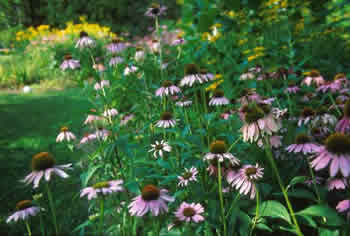A rain garden is an attractive way to reduce runoff from your property. A rain garden collects rainwater that runs off of roofs, driveways, or other hard (impermeable) surfaces, and then allows the water to soak slowly into the soil along the plants’ root channels.

A rain garden is much like a regular perennial garden, except the base is dug between 4 and 12 inches deep. This sunken base allows the garden to catch and collect runoff water, often directed into the garden from a rain gutter downspout. The area and depth of a rain garden is determined based on the drainage area and the soil type. After a rain event fills a rain garden, the water should soak into the soil relatively quickly. Particularly permeable soils may drain faster (minutes or hours), while less permeable soils may require more time (hours).
Rain gardens are planted with native perennial flowers. Their deep root systems anchor the soil in place and create channels through which water can percolate into the soil. In addition, these native plants attract many species of birds and butterflies. They do not breed mosquitoes, though, since standing water is not present for the three to five days that their reproductive cycle requires.
While both beautiful and functional, rain gardens are no more difficult to maintain than a normal garden. Once constructed, a rain garden will simply require regular weeding and perhaps watering (depending on the amount of rain received) for the first few years until the plants are established. Since they are native plants, adapted to the climate and weather of this region, they will require minimal care after this point.
Click on the this link to see pictures of rain gardens installed around Balsam Lake!

